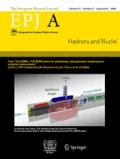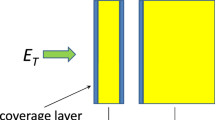Abstract.
Pulse shape analysis for light particles (\(Z \leq 2\)) is studied in a 500 μm thick Double-Sided Stripped Silicon Detector (DSSSD) of nTD type with a pitch lower than 500 μm. Good separation between the \(Z = 1\) isotopes is achieved irrespective of the side used for signal pick up with the detector biased at depletion voltage. The low energy threshold for discrimination between \(Z = 1\) isotopes is found to be around 2.5 MeV at depletion voltage and the quality of the separation can be slightly improved by using filtering methods. On the other hand, the discrimination performances are enhanced when lowering the bias of the detector at the expense of energy resolution. At nominal bias (i.e. overdepletion) where the energy resolution is the best, no separation between the three hydrogen isotopes is achieved when using the amplitude of the current signal. Discrimination can still be obtained by acquiring the time over a threshold set at 10% of the amplitude after applying a square bipolar filter to the current signal. Besides, in view of the design of the front-end electronics, the effect of the sampling rate needed for pulse shape analysis has been investigated and shows that below 200 MSa/s, the discrimination quality is strongly reduced.
Similar content being viewed by others
References
Y. Blumenfeld et al., Nucl. Instrum. Methods A 421, 471 (1999)
E. Pollacco et al., Eur. Phys. J. A 25, 287 (2005)
S.D. Pain et al., Nucl. Instrum. Methods B 261, 1222 (2007)
V. Bildstein et al., Eur. Phys. J. A 48, 85 (2012)
M. Labiche et al., Nucl. Instrum. Methods A 614, 439 (2010)
D. Beaumel et al., Nucl. Instrum. Methods B 31, 661 (2013) and http://gaspard.in2p3.fr
HYbrid DEtector array, http://www.uhu.es/gem/proyectos/hyde
TRacking Array for light Charged particle Ejectiles, http://web.infn.it/spes/index.php/research-on-nuclear-physics/150-trace
J. Simpson, J. Phys. G: Nucl. Part. Phys. 31, S1801 (2005)
Photon Array for studies with Radioactive Ion and Stable beams, http://paris.ifj.edu.pl/
J.B.A. England, G.M. Field, T.R. Ophel, Nucl. Instrum. Methods A 280, 291 (1989)
C.A.J. Ammerlaan, R.F. Rumphorst, L.A.Ch. Koerts, Nucl. Instrum. Methods 22, 189 (1963)
G. Pausch et al., Nucl. Instrum. Methods A 349, 281 (1994)
M. Mutterer et al., IEEE Trans. Nucl. Sc. 47, 756 284 (2000) DOI:10.1109/23.856510
M. Chabot et al., Nucl. Instrum. Methods Phys. Res. B 197, 155 (2002)
R. Bougault et al., Eur. Phys. J. A 50, 47 (2014) and http://fazia.in2p3.fr
L. Bardelli et al., Nucl. Instrum. Methods A 602, 501 (2009)
L. Bardelli et al., Nucl. Instrum. Methods A 605, 353 (2009)
S. Barlini et al., Nucl. Instrum. Methods A 600, 644 (2009)
L. Bardelli et al., Nucl. Instrum. Methods A 654, 272 (2011)
S. Carboni et al., Nucl. Instrum. Methods A 664, 251 (2012)
N. Le Neindre et al., Nucl. Instrum. Methods A 701, 145 (2013)
S. Barlini et al., Nucl. Instrum. Methods A 707, 89 (2013)
J.A. Dueñas et al., Nucl. Instrum. Methods A 676, 70 (2012) DOI:10.1016/j.nima.2012.02.032
J.A. Dueñas et al., Nucl. Instrum. Methods A 714, 48 (2013) DOI:10.1016/j.nima.2013.02.032
D. Mengoni et al., Nucl. Instrum. Methods A 764, 241 (2014)
M. von Schmid et al., Nucl. Instrum. Methods A 629, 197 (2011)
J.A. Dueñas et al., Nucl. Instrum. Methods A 743, 44 (2014)
Micron Semiconductor Ltd, http://www.micronsemiconductor.co.uk
H. Hamrita et al., Nucl. Instrum. Methods A 531, 607 (2004)
D. Breton, E. Delagnes, M. Houry, Nucl. Sci., IEEE Trans. 52/6, 2853 (2005) CAEN V1729A http://www.caen.it
A. Boujrad, F. Saillant, Nucl. Sci. Sympos. Conf. Record 2, 12 (2000)
X. Grave, R. Canedo, J.-F. Clavelin, S. Du, E. Legay, Proceedings of the Real Time Conference, 14th IEEE-NPSS (2005) p. 5
E. Gatti, P.F. Manfredi, Riv. Nuovo Cimento 9, 1 (1986) DOI:10.1007/BF02822156
B. Genolini et al., Nucl. Instrum. Methods A 732, 87 (2013)
M.D.Z. James, F. Ziegler, Jochen P. Biersack, SRIM: The Stopping and Range of Ions in Matter (Lulu Press Co., 2009)
M. Parlog, H. Hamrita, B. Borderie, Nucl. Instrum. Methods A 613, 290 (2010)
H. Hamrita et al., Nucl. Instrum. Methods A 642, 59 (2011)
G. Pasquali et al., Eur. Phys. J. A 50, 86 (2014)
R. Brun, F. Rademakers, Nucl. Instrum. Methods Phys. Res. A 389, 81 (1997) DOI:10.1016/S0168-9002(97)00048-X see also http://root.cern.ch/
L. Pollacco, GET: A Generic Electronic System for TPCs for nuclear physics experiments, Physics Procedia - TIPP 2011 - Technology and Instrumentation for Particle Physics (Chicago, 2011) http://hal.in2p3 fr/in2p3-00738205
C.E. Shannon, Proc. Inst. Radio Eng. 37, 10 (1949)
Author information
Authors and Affiliations
Corresponding author
Additional information
Communicated by P. Woods
Rights and permissions
About this article
Cite this article
Assié, M., Le Crom, B., Genolini, B. et al. Characterization of light particles (Z ≤ 2) discrimination performances by pulse shape analysis techniques with high-granularity silicon detector. Eur. Phys. J. A 51, 11 (2015). https://doi.org/10.1140/epja/i2015-15011-6
Received:
Revised:
Accepted:
Published:
DOI: https://doi.org/10.1140/epja/i2015-15011-6



